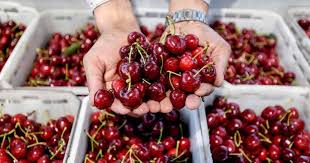Pakistani cherries set to enhance competition in Chinese market

Beijing: China is the world’s largest cherry market and Pakistan has reached a milestone by exporting its first shipment of fresh cherries to China.
Utilising a reefer container, Pakistan aims to export 260 tonnes of fresh cherries to China in reefer containers by the end of June.
This achievement is a result of a phytosanitary agreement signed between China and Pakistan in 2022, which granted Pakistani fresh cherries access to the Chinese market. Fruit farmers in Pakistan’s northern Gilgit-Baltistan region are optimistic that their new access to the Chinese market will bolster the local economy and the successful dispatch of this consignment marks a promising step forward, CGTN reported.
The Gilgit-Baltistan region of Pakistan, known for its diverse fruit varieties such as sweet cherries, tangy apricots and juicy pears, benefits from an ideal environment. Nourished by fresh glacial water, ripened under golden sunbeams and sustained by gentle breezes from some of the world’s highest peaks, these cherries offer a delightful taste experience.
Exporting fresh cherries to the Chinese market could significantly improve the lives of local Pakistani growers.
Chinese consumers hold cherries in high regard due to their rich colour – red traditionally symbolises good fortune – and their juicy, sweet flavour. Cherries are commonly gifted as presents, making both taste and appearance crucial factors. In China, there is a preference for cherries that are sweet, firm and have a deep red colour ranging from mahogany to dark, measuring between 28 and 30 millimetres.
Despite its recent success, Pakistan faces challenges in becoming competitive in cherry production and processing on a global scale. Currently, Pakistani cherries have only reached a handful of international markets, such as the United Arab Emirates (UAE). This limitation is largely due to local farmers’ lack of knowledge about the processes and procedures required to register their products internationally. Without proper guidance and modern technology, obtaining international certifications remains challenging, thus hindering their access to foreign high-end trading hubs.
In the Chinese market, Pakistani cherries are not only facing competition from domestically grown cherries from Shandong and Liaoning provinces but also from fresh cherries imported from countries like Chile. Dominant market players, like Chile, are currently exporting 85 per cent of their cherries to China annually. Kyrgyzstan is also one of the newly listed cherry suppliers to China.
In 2024, it is possible that Kyrgyzstan will export up to 10,000 tonnes of fresh cherries to China. Additionally, new entrants, such as Tajikistan, are making inroads into the Chinese market.
Pakistan’s entry into the Chinese cherry market represents a promising development while achieving greater competitiveness will be crucial in the long run. Providing local farmers with the necessary knowledge, guidance and technology can help them meet international standards and tap into lucrative markets.
With these improvements, Pakistan’s cherry industry could thrive and make a more significant impact on the global stage.





